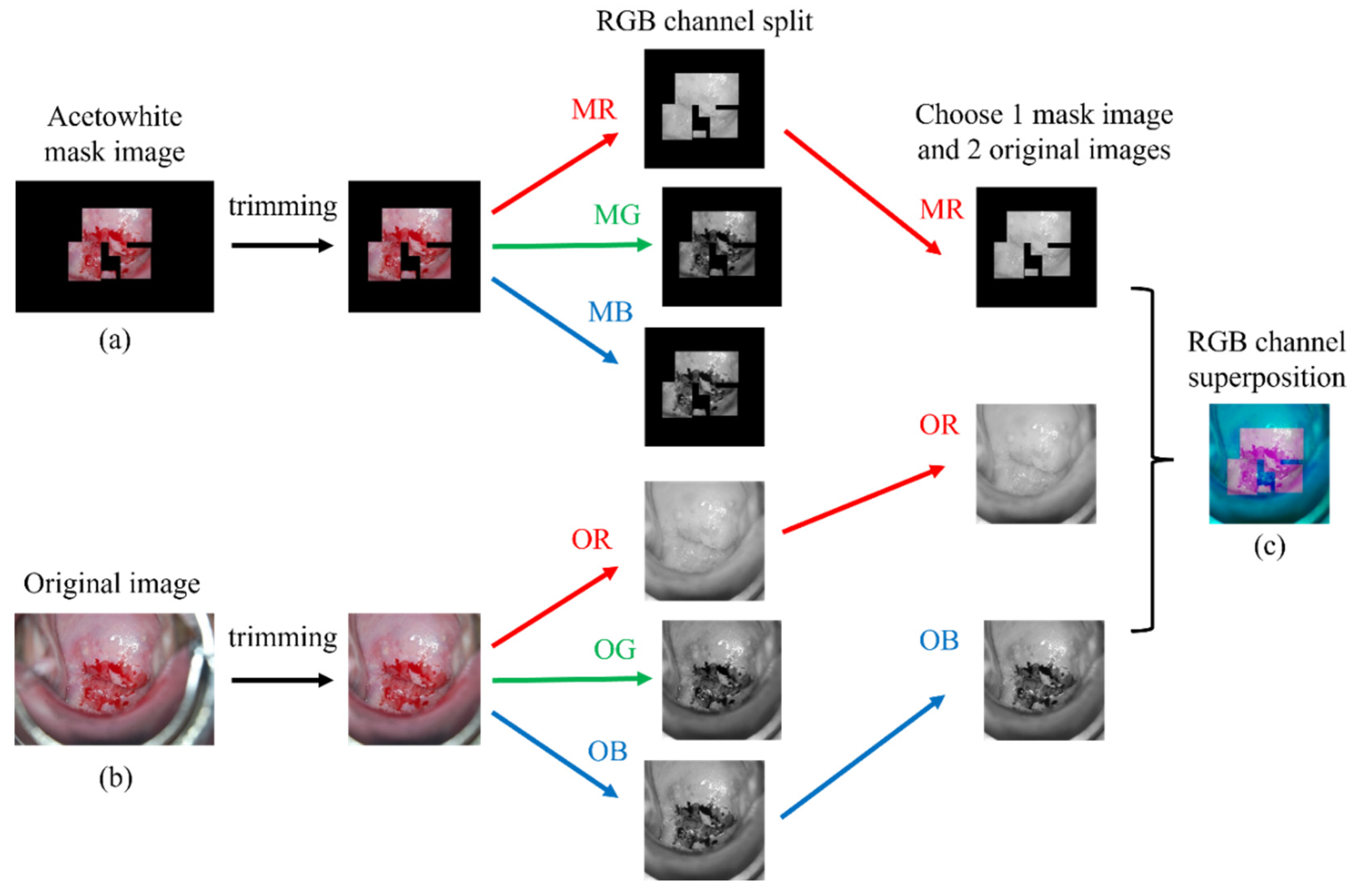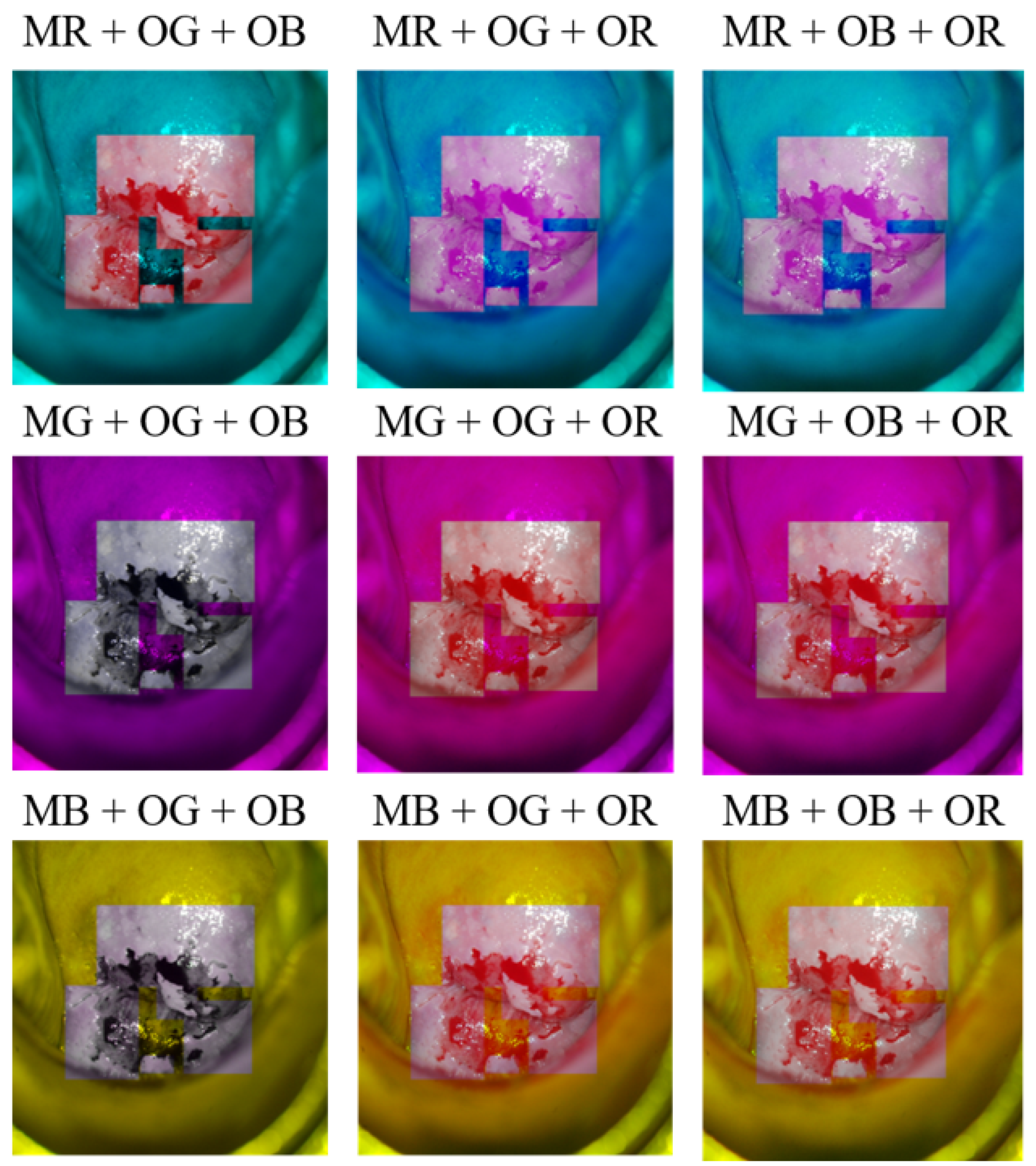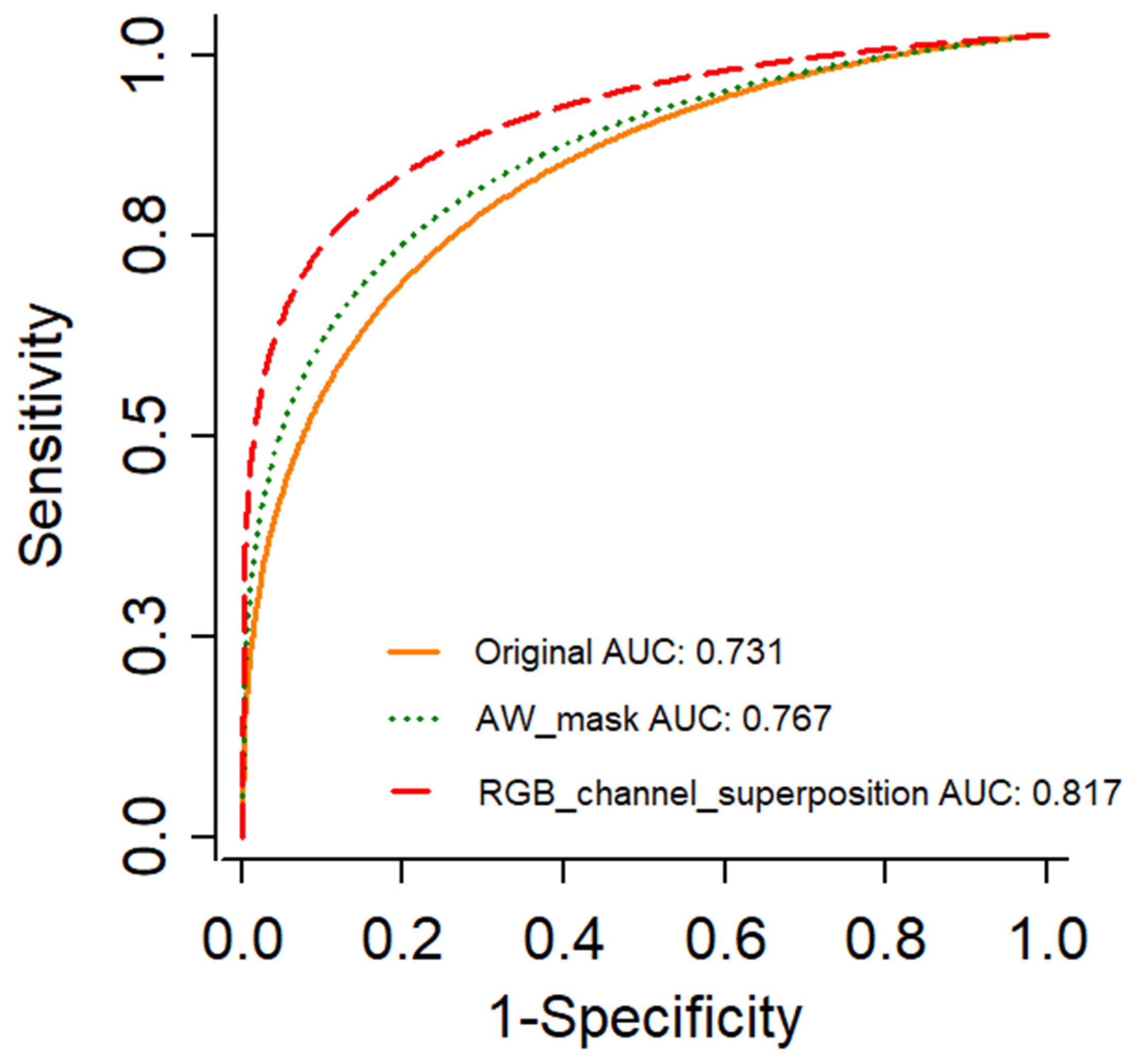RGB Channel Superposition Algorithm with Acetowhite Mask Images in a Cervical Cancer Classification Deep Learning Model
Abstract
1. Introduction
2. Methods
2.1. Data
2.2. Image Preprocessing
2.3. RGB Channel Superposition
2.4. Classification Deep Learning Model
2.5. Evaluation of the Deep Learning Model Performance
2.6. Statistical Analysis
3. Results
4. Conclusions
Author Contributions
Funding
Institutional Review Board Statement
Informed Consent Statement
Data Availability Statement
Conflicts of Interest
References
- Stelzle, D.; Tanaka, L.F.; Lee, K.K.; Ibrahim Khalil, A.; Baussano, I.; Shah, A.S.V.; McAllister, D.A.; Gottlieb, S.L.; Klug, S.J.; Winkler, A.S.; et al. Estimates of the global burden of cervical cancer associated with HIV. Lancet Glob. Health 2021, 9, e161–e169. [Google Scholar] [CrossRef]
- Schneider, D.L.; Herrero, R.; Bratti, C.; Greenberg, M.D.; Hildesheim, A.; Sherman, M.E.; Morales, J.; Hutchinson, M.L.; Sedlacek, T.V.; Lorincz, A.; et al. Cervicography screening for cervical cancer among 8460 women in a high- risk population. Am. J. Obstet. Gynecol. 1999, 180, 290–298. [Google Scholar] [CrossRef]
- World Health Organization. Global Strategy to Accelerate the Elimination of Cervical Cancer as a Public Health Problem and Its Associated Goals and Targets for the Period 2020–2030. In United Nations General Assembly; United Nations: New York, NY, USA, 2020; p. 2. [Google Scholar]
- Saslow, D.; Solomon, D.; Lawson, H.W.; Killackey, M.; Kulasingam, S.L.; Cain, J.; Garcia, F.A.R.; Moriarty, A.T.; Waxman, A.G.; Wilbur, D.C.; et al. American Cancer Society, American Society for Colposcopy and Cervical Pathology, and American Society for Clinical Pathology screening guidelines for the prevention and early detection of cervical cancer. CA Cancer J. Clin. 2012, 62, 147–172. [Google Scholar] [CrossRef] [PubMed]
- Panici, P.B.; Angioli, R.; Penalver, M.; Pecorelli, S. Cervical cancer. Chemother. Gynecol. Neoplasms Curr. Ther. Nov. Approaches 2004, 361, 547–554. [Google Scholar]
- Cronjé, H.S.; Cooreman, B.F.; Beyer, E.; Bam, R.H.; Middlecote, B.D.; Divall, P.D.J. Screening for cervical neoplasia in a developing country utilizing cytology, cervicography and the acetic acid test. Int. J. Gynecol. Obstet. 2001, 72, 151–157. [Google Scholar] [CrossRef]
- Goldie, S.J.; Gaffikin, L.; Goldhaber-Fiebert, J.D.; Gordillo-Tobar, A.; Levin, C.; Mahé, C.; Wright, T.C. Cost-Effectiveness of Cervical-Cancer Screening in Five Developing Countries. N. Engl. J. Med. 2005, 353, 2158–2168. [Google Scholar] [CrossRef]
- Bedell, S.L.; Goldstein, L.S.; Goldstein, A.R.; Goldstein, A.T. Cervical Cancer Screening: Past, Present, and Future. Sex Med. Rev. 2020, 8, 28–37. [Google Scholar] [CrossRef]
- Jeronimo, J.; Schiffman, M. Colposcopy at a crossroads. Am. J. Obstet. Gynecol. 2006, 195, 349–353. [Google Scholar] [CrossRef]
- Mitchell, M.F.; Schottenfeld, D.; Tortolero-Luna, G.; Cantor, S.B.; Richards-Kortum, R. Colposcopy for the diagnosis of squamous intraepithelial lesions: A meta-analysis. Obstet. Gynecol. 1998, 91, 626–631. [Google Scholar] [CrossRef]
- Stafl, A. Cervicography: A new method for cervical cancer detection. Am. J. Obstet. Gynecol. 1981, 139, 815–821. [Google Scholar] [CrossRef]
- Szarewski, A.; Cuzick, J.; Edwards, R.; Butler, B.; Singer, A. The use of cervicography in a primary screening service. Obstet. Gynecol. Surv. 1991, 46, 632–633. [Google Scholar] [CrossRef]
- Kim, Y.T.; Kim, J.W.; Kim, S.H.; Kim, Y.R.; Kim, J.H.; Yoon, B.S.; Park, Y.W. Clinical usefulness of cervicogram as a primary screening test for cervical neoplasia. Yonsei Med. J. 2005, 46, 213–220. [Google Scholar] [CrossRef] [PubMed]
- Li, W.; Venkataraman, S.; Gustafsson, U.; Oyama, J.C.; Ferris, D.G.; Lieberman, R.W. Using acetowhite opacity index for detecting cervical intraepithelial neoplasia. J. Biomed. Opt. 2009, 14, 014020. [Google Scholar] [CrossRef] [PubMed]
- Shaw, E.; Sellors, J.; Kaczorowski, J. Prospective evaluation of colposcopic features in predicting cervical intraepithelial neoplasia: Degree of acetowhite change most important. J. Low. Genit. Tract Dis. 2003, 7, 6–10. [Google Scholar] [CrossRef] [PubMed]
- Wu, T.; Cheung, T.-H.; Yim, S.-F.; Qu, J.Y. Clinical study of quantitative diagnosis of early cervical cancer based on the classification of acetowhitening kinetics. J. Biomed. Opt. 2010, 15, 026001. [Google Scholar] [CrossRef] [PubMed]
- Balas, C.J.; Themelis, G.C.; Prokopakis, E.P.; Orfanudaki, I.; Koumantakis, E.; Helidonis, E.S. In vivo detection and staging of epithelial dysplasias and malignancies based on the quantitative assessment of acetic acid-tissue interaction kinetics. J. Photochem. Photobiol. B Biol. 1999, 53, 153–157. [Google Scholar] [CrossRef]
- Basu, P.; Sankaranarayanan, R. Atlas of Colposcopy—Principles and Practice: IARC CancerBase No. 13 [Internet]; International Agency for Research on Cancer: Lyon, France, 2017; Available online: https://screening.iarc.fr/atlascolpo.php (accessed on 5 October 2021).
- Acosta-Mesa, H.G.; Cruz-Ramírez, N.; Hernández-Jiménez, R. Aceto-White temporal pattern classification using k-NN to identify precancerous cervical lesion in colposcopic images. Comput. Biol. Med. 2009, 39, 778–784. [Google Scholar] [CrossRef]
- Huang, S.; Gao, M.; Yang, D.; Huang, X.; Elgammal, A.; Zhang, X. Unbalanced graph-based transduction on superpixels for automatic cervigram image segmentation. In Proceedings of the International Symposium on Biomedical Imaging, New York, NY, USA, 16–19 April 2015; pp. 1556–1559. [Google Scholar]
- Yue, Z.; Ding, S.; Li, X.; Yang, S.; Zhang, Y. Automatic Acetowhite Lesion Segmentation via Specular Reflection Removal and Deep Attention Network. IEEE J. Biomed. Health Inform. 2021, 25, 3529–3540. [Google Scholar] [CrossRef]
- Liu, J.; Liang, T.; Peng, Y.; Peng, G.; Sun, L.; Li, L.; Dong, H. Segmentation of acetowhite region in uterine cervical image based on deep learning. Technol. Health Care 2021, 30, 469–482. [Google Scholar] [CrossRef]
- Xiong, J.; Wang, L.; Gu, J. Image segmentation of the acetowhite region in cervix images based on chromaticity. In Final Program and Abstract Book, Proceedings of the 9th International Conference on Information Technology and Applications in Biomedicine, ITAB, Larnaca, Cyprus, 5–7 November 2009; IEEE: Piscataway, NJ, USA, 2009. [Google Scholar]
- Marquez-Grajales, A.; Acosta-Mesa, H.G.; Mezura-Montes, E.; Hernandez-Jimenez, R. Cervical image segmentation using active contours and evolutionary programming over temporary acetowhite patterns. In Proceedings of the 2016 IEEE Congress on Evolutionary Computation, CEC 2016, Vancouver, BC, Canada, 24–29 July 2016; pp. 3863–3870. [Google Scholar]
- Kudva, V.; Prasad, K.; Guruvare, S. Detection of Specular Reflection and Segmentation of Cervix Region in Uterine Cervix Images for Cervical Cancer Screening. Irbm 2017, 38, 281–291. [Google Scholar] [CrossRef]
- Yun, J.W. Deep Residual Learning for Image Recognition. Enzym. Microb. Technol. 1996, 19, 107–117. [Google Scholar] [CrossRef]
- Zhuang, F.; Qi, Z.; Duan, K.; Xi, D.; Zhu, Y.; Zhu, H.; Xiong, H.; He, Q. A Comprehensive Survey on Transfer Learning. Proc. IEEE 2021, 109, 43–76. [Google Scholar] [CrossRef]
- Rehman, A.; Naz, S.; Imran, M.; Akram, F.; Imran, M. A Deep Learning-Based Framework for Automatic Brain Tumors Classification Using Transfer Learning. Circuits Syst. Signal Process. 2020, 39, 757–775. [Google Scholar] [CrossRef]
- Demšar, J. Statistical comparisons of classifiers over multiple data sets. J. Mach. Learn. Res. 2006, 7, 1–30. [Google Scholar]
- Pogue, B.W.; Kaufman, H.B.; Zelenchuk, A.; Harper, W.; Burke, G.C.; Burke, E.E.; Harper, D.M. Analysis of acetic acid-induced whitening of high-grade squamous intraepithelial lesions. J. Biomed. Opt. 2001, 6, 397. [Google Scholar] [CrossRef] [PubMed][Green Version]





| Precision (%) | Recall (%) | F1-Score (%) | Accuracy (%) | |
|---|---|---|---|---|
| MR + OG+ OB | 90.18 | 68.51 | 77.51 | 79.56 |
| MR + OG + OR | 89.60 | 69.59 | 77.96 | 79.89 |
| MR + OB + OR | 90.05 | 72.55 | 79.94 | 81.31 |
| MG + OG + OB | 89.18 | 70.46 | 78.61 | 80.22 |
| MG + OG + OR | 89.75 | 70.03 | 78.37 | 80.22 |
| MG + OB + OR | 89.86 | 68.96 | 77.85 | 79.67 |
| MB + OG + OB | 91.19 | 68.53 | 77.58 | 79.89 |
| MB + OG + OR | 87.88 | 70.65 | 78.10 | 79.67 |
| MB + OB + OR | 88.77 | 68.35 | 77.26 | 78.80 |
| Precision (%) | Recall (%) | F1-Score (%) | Accuracy (%) | |
|---|---|---|---|---|
| Original image | 84.73 | 57.45 | 68.25 | 72.46 |
| Acetowhite mask | 84.70 | 66.45 | 74.41 | 76.28 |
| RGB channel superposition | 90.05 | 72.55 | 79.94 | 81.31 |
Publisher’s Note: MDPI stays neutral with regard to jurisdictional claims in published maps and institutional affiliations. |
© 2022 by the authors. Licensee MDPI, Basel, Switzerland. This article is an open access article distributed under the terms and conditions of the Creative Commons Attribution (CC BY) license (https://creativecommons.org/licenses/by/4.0/).
Share and Cite
Kim, Y.J.; Ju, W.; Nam, K.H.; Kim, S.N.; Kim, Y.J.; Kim, K.G. RGB Channel Superposition Algorithm with Acetowhite Mask Images in a Cervical Cancer Classification Deep Learning Model. Sensors 2022, 22, 3564. https://doi.org/10.3390/s22093564
Kim YJ, Ju W, Nam KH, Kim SN, Kim YJ, Kim KG. RGB Channel Superposition Algorithm with Acetowhite Mask Images in a Cervical Cancer Classification Deep Learning Model. Sensors. 2022; 22(9):3564. https://doi.org/10.3390/s22093564
Chicago/Turabian StyleKim, Yoon Ji, Woong Ju, Kye Hyun Nam, Soo Nyung Kim, Young Jae Kim, and Kwang Gi Kim. 2022. "RGB Channel Superposition Algorithm with Acetowhite Mask Images in a Cervical Cancer Classification Deep Learning Model" Sensors 22, no. 9: 3564. https://doi.org/10.3390/s22093564
APA StyleKim, Y. J., Ju, W., Nam, K. H., Kim, S. N., Kim, Y. J., & Kim, K. G. (2022). RGB Channel Superposition Algorithm with Acetowhite Mask Images in a Cervical Cancer Classification Deep Learning Model. Sensors, 22(9), 3564. https://doi.org/10.3390/s22093564







